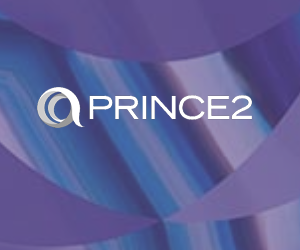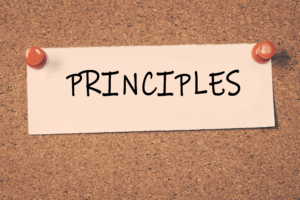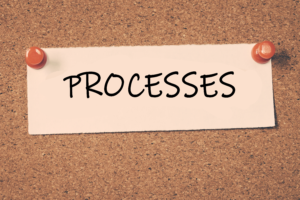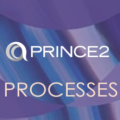
PRINCE2 is one of the world’s main project management methodologies. It was developed by the UK government and is administered by Axelos, a company partially owned by the UK government.
Axelos administers the two PRINCE2 certifications: PRINCE2 Foundation and PRINCE2 Practitioner. The latter is the main certification, and the former is the more basic, “associate” certification.
In the PRINCE2 methodology, projects are divided into “management stages” which are similar to project phases. During and at the end of each management stage, certain things must happen.
These things are governed by the three main categories, which form the core of PRINCE2 methodology:
- Seven Principles
- Seven Themes
- Seven Processes
The Seven Principles
 The seven principles are guiding philosophies which apply to all projects. They are a project constitution of sorts. The seven principles are:
The seven principles are guiding philosophies which apply to all projects. They are a project constitution of sorts. The seven principles are:
- Continued business justification
PRINCE2 requires that all project have a justifiable reason for starting the project, that it is recorded and approved, and that this justification remains valid. It must be revalidated throughout the life cycle of the project. This justification must be documented in the form of a Business Case, which is confirmed by the project board at each management stage boundary. The Business Case drives decision making to ensure the project provides the expected benefits to the parent organization. - Learn from experience
The project must obtain lessons learned from other projects as well as the parent organization during the initiation stage. Throughout the project, it must continually glean lessons learned and use them to improve project processes and procedures. And at the end of the project, it must compile the lessons learned to allow others to achieve the same benefits. - Defined roles and responsibilities
PRINCE2 projects must have clearly defined roles and responsibilities that define the three major interests:- Business stakeholders are those that have a business interest in the project, like executive, corporate sponsors, and investors.
- Users are those that use the project’s products to improve their daily lives. They wish to have a product or service that improves their lives with minimal hassle and cost.
- Suppliers are stakeholders who are involved in carrying out the project. They include external contractors as well as the project team, who have needs related to career goals and work satisfaction.
- Manage by stages
PRINCE2 projects are broken into management stages. There are a minimum of two stages – For small projects the first is the initiation stage, and the second is the project execution stage. The choice of number of management stages is dependent on the size and complexity of the project, natural phase breaks or major project deliverables. - Manage by exception
The project board dictates tolerances for the project in six areas. If the project deviates outside of the tolerances in any one area, the project manager must create an Exception Plan, which replaces the Project Plan for that stage. The project board approves the Exception Plan before it is implemented.- Cost
- Time
- Quality
- Scope
- Benefits
- Risk
- Focus on products
In projects, it is remarkably easy to get wrapped up in processes and lose sight of the end goal. PRINCE2 therefore mandates that projects focus on products instead of processes. The products that the project is to produce are analyzed for expectations of quality and interpretations of function and form. The Product Descriptions are created by the project manager and approved by the project board and the customer or client. - Tailor to suit the project
The processes and themes of PRINCE2 need to be tailored to suit the project environment, size, complexity, team capability, importance, and risk. It is a universal project management system that can be applied to all projects, but its products and methods require adjustments to suit each individual project.
The Seven Themes
 The seven themes are like knowledge areas that are drawn on whenever necessary. They are used at any time within the project. The seven themes are:
The seven themes are like knowledge areas that are drawn on whenever necessary. They are used at any time within the project. The seven themes are:
- Business case
The business case theme is at the heart of the PRINCE2 method, as it establishes why a project is being done. This theme develops the business case upon which the project is based. It also develops the benefits management approach which establishes the benefits that the parent organization wishes to realize from the project, and how the project will ensure that they are realized. Both of these documents are revalidated at the end of each management stage. - Organization
This theme establishes the project organizational chart, that is, who is in what roles and what their responsibilities are. PRINCE2 defines a group of standard project roles which must be fulfilled. Some people can fill multiple roles, especially for small projects. The roles are:- Corporate, programme management or the customer
- Executive
- Senior user
- Senior supplier
- Project manager
- Team manager
- Project assurance
- Project support
- Quality
Quality is the degree to which a set of characteristics fulfill requirements. PRINCE2’s quality theme embodies the activities necessary to define the quality requirements and determine if the products or services are fulfilling them. The quality theme is divided into two components:- Quality planning includes the determination of the quality standards for the products or services that the project will produce. These standards can be determined from internal requirements, or obtained from external standards bodies. The customer quality expectations are defined and the quality measurement frequency is established.
- Quality control involves measuring the quality of the products against the metrics determined in the planning stage.
- Plans
Plans are a foundational requirement in any project. Without plans, there can be no control. In PRINCE2, plans must describe not only timelines but also what will be delivered, how, and by whom. The project plans must establish targets, as well as tolerance levels, for the six main ingredients: Time, cost, quality, scope, benefits, and risk. The product description provides the detailed information necessary to produce it. The plans are produced at the project level, at the stage level, and at the team level. There is no prescribed format for the plans, but anything that can define the required information will be acceptable. - Risk
PRINCE2 mandates that projects contains a risk register, which documents known risks to the project’s success and prioritizes them. Opportunities are the opposite of risks (risks with a positive outcome) and their exploitation is equally as important as the minimization of risks. A risk management approach details the methods for identification of risks and opportunities, how their impact and probability will be prioritized and what the risk response plans will be. - Change
Project changes are a virtual fact of life – It is rare that a project’s completion date, budget, or final product is exactly as planned at the start of the project. Hence, PRINCE2 mandates an issue log which tracks issues. If the issue can be dealt with inside the tolerances given by the project board, the project manager can create an issue report and move on. If not, the project manager must submit an Exception Report which is approved by the project board. Once approved, the Exception Plan replaces the current Stage Plan that has been invalidated. - Progress
The progress theme measures the actual performance of the project against the plan. The progress is measured against the six targets of time, cost, quality, scope, benefits, and risk. Controls are either time driven (occurring at specified intervals) or event driven (occurring in response to an event). Any deviation outside the tolerances triggers an exception report, which must be approved by the project board.
The Seven Processes
 The seven processes are the activities that are carried out in the management of projects. They are the physical work that needs to be done. The seven processes are:
The seven processes are the activities that are carried out in the management of projects. They are the physical work that needs to be done. The seven processes are:
- Starting up a project
This process includes the activities necessary to put in place the prerequisites for the initiation (planning) of the project. It occurs before the project is approved and its viability certified. That is, the decision to proceed with the project happens after this process. The process has six activities within it:- Appoint the executive and project manager
- Capture previous lessons
- Design and appoint the project management team
- Prepare the outline business case
- Select the project approach and assemble the project brief
- Plan the initiation stage
- Directing a project
This project is focused on the project board, and most of its activities are performed by them. This process encompasses the entire project, from beginning to end. It involves primarily the authorization of each stage of the project, including project plans and exception plans, and delegating project decision making authority. The five activities are:- Authorize initiation
- Authorize the project
- Authorize a stage or exception plan
- Give ad hoc direction
- Authorize project closure
- Initiating a project
This process involves the creation of the project plans, including the schedules, budgets, quality specifications, and project controls. It establishes the project team and their roles and responsibilities. It defines the baselines of time, cost, scope, quality, benefits, and risk, as well as the tolerances under which they will operate. The Initiating a Project process enables the project board to decide whether the project is sufficiently aligned with corporate, programme management or customer goals to authorize its continuation. There are nine activities within this process:- Agree the tailoring requirements
- Prepare the risk management approach
- Prepare the change control approach
- Prepare the quality management approach
- Prepare the communication management approach
- Set up the project controls
- Create the project plan
- Prepare the benefits management approach
- Assemble the project initiation documentation
- Controlling a stage
Throughout each management stage, the project manager must carry out project control activities, which are aimed at determining whether the project is within tolerances of time, cost, scope, quality, benefits, and risk. If at any time the tolerances are exceeded, the project has lost the confidence of the project board. An Exception Plan must be prepared which, after being approved by the project board, replaces the old project plan. The activities of this process are mostly performed by the project manager, and they are:- Authorize a work package
- Review work package status
- Receive completed work packages
- Review the management stage status
- Report highlights
- Capture and assess issues and risks
- Escalate issues and risks
- Take corrective action
- Managing product delivery
This process occurs entirely within the previous process (Controlling a Stage). It is aimed at the team manager, who directs project work and reports to the project manager. It involves the day to day work of producing the product or service that the project was created to produce. The three activities within this process are:- Accept a work package
- Execute a work package
- Deliver a work package
- Managing a stage boundary
As the end of a management stage nears, the project manager must prepare for the next stage and ensure that approvals are in place so there are no work interruptions. The project board must approve the new stage plan and confirm the business case for the next stage. Hence, the stage plan must be produced, and it includes the six items of time, cost, scope, quality, benefits, and risk. The five activities within this process are:- Plan the next management stage
- Update the project plan
- Update the business case
- Report management stage end
- Produce an exception plan
- Closing a project
Closing well is one of the project managers most exciting phases. Closing tasks are often small, yet highly visible to senior management. The five activities within this process are:- Prepare planned closure
- Prepare premature closure
- Hand over products
- Evaluate the project
- Recommend project closure






